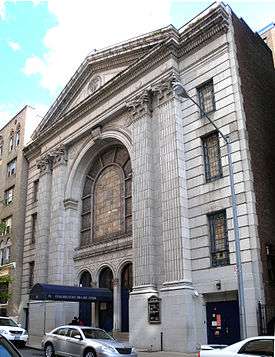Congregation Shaare Zedek (New York City)
| Congregation Shaare Zedek | |
|---|---|
|
Sanctuary main entrance | |
| Basic information | |
| Location |
212 West 93rd Street, Manhattan, New York, |
| Affiliation | Conservative Judaism |
| Status | Active |
| Website | www.sznyc.org |
| Architectural description | |
| Architect(s) | Somerfeld and Steckler |
| Architectural style | Classical Revival |
| Groundbreaking | 1922 |
| Completed | 1923 |
| Materials | Granite |
Congregation Shaare Zedek (Gates of righteousness) is a Conservative synagogue located on West 93rd Street in Manhattan.
History
Founded in 1837, by Polish Jews, Shaare Zedek is the third oldest Jewish congregation in New York City. The congregation originally met at 38 Henry Street on Manhattan's Lower East Side. In 1850, it purchased a building at 38 Henry Street (still on the Lower East Side) that was originally built by a Quaker congregation in 1828 that had been converted for use as a synagogue by congregation Ansche Chesed in 1840.[1] The congregation replaced this building with a new building on the same property in 1891 and in 1900 opened a branch synagogue at 25 West 118th Street in the newly fashionable neighborhood of Harlem.[2] The building is now a church. The Henry Street building was sold to Congregation Mishkan Israel Anshei Suwalk in 1911.
Shaare Zedek's present, elaborate, Neoclassical building was designed by the architecture firm of Sommerfeld and Steckler and built in 1922-1923.
Over the years, Shaare Zedek has been home to some of the country's great rabbis including Philip R. Alstat, Israel Goldfarb, and Isaac Kurtzlow along with such esteemed cantors as David Roitman, Frank Birnbaum and Martin Kozlowsky. From 2009 to 2014, the congregation was led by Rabbi William Plevan. Although Shaare Zedek was the last Conservative synagogue in the area to allow fully egalitarian worship, women now participate in every aspect of the service and the congregation was recently served by a female rabbi. While preserving the traditional liturgy quite closely and committing to a fairly strict observance of Jewish law, the community is generally politically and socially progressive.
See also
References
- ↑ Dunlap, David W. From Abyssinian to Zion: A Guide to Manhattan's Houses of Worship, Columbia University Press, 2004, p. 260.
- ↑ Israelowitz, Oscar. Synagogues of New York City: A Pictorial Survey in 123 Photographs, Dover Publications, 1982, p. 63.
External links
Coordinates: 40°47′27.2″N 73°58′23.6″W / 40.790889°N 73.973222°W
